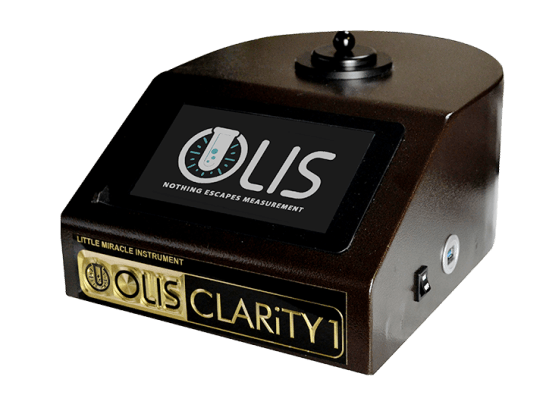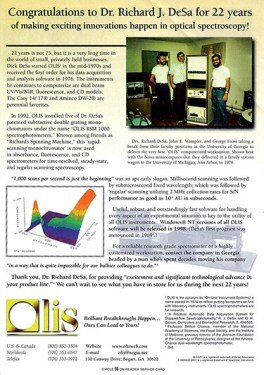Some Known Facts About Circular Dichroism.
Some Known Facts About Circular Dichroism.
Blog Article
What Does Spectrophotometers Do?
Table of Contents5 Simple Techniques For Uv/vis/nirHow Uv/vis can Save You Time, Stress, and Money.Circular Dichroism Fundamentals ExplainedCircular Dichroism Things To Know Before You BuyGet This Report about Spectrophotometers

Although spectrophotometry is most commonly applied to ultraviolet, noticeable, and infrared radiation, modern spectrophotometers can question wide swaths of the electromagnetic spectrum, including x-ray, ultraviolet, visible, infrared, and/or microwave wavelengths. Spectrophotometry is a tool that hinges on the quantitative analysis of molecules depending upon how much light is taken in by colored substances.
Indicators on Spectrophotometers You Should Know
A spectrophotometer is frequently used for the measurement of transmittance or reflectance of services, transparent or opaque solids, such as sleek glass, or gases. Lots of biochemicals are colored, as in, they soak up visible light and for that reason can be measured by colorimetric procedures, even colorless biochemicals can often be converted to colored compounds appropriate for chromogenic color-forming responses to yield compounds suitable for colorimetric analysis.: 65 Nevertheless, they can likewise be created to measure the diffusivity on any of the listed light ranges that typically cover around 2002500 nm using various controls and calibrations.
An example of an experiment in which spectrophotometry is used is the determination of the stability constant of a service. A certain chemical response within a solution might take place in a forward and reverse instructions, where reactants form products and items break down into reactants. Eventually, this chain reaction will reach a point of balance called a stability point.
Top Guidelines Of Spectrophotometers
The amount of light that travels through the solution is a sign of the concentration of specific chemicals that do not enable light to pass through. The absorption of light is because of the interaction of light with the electronic and vibrational modes of particles. Each kind of particle has a specific set of energy levels related to the makeup of its chemical bonds and nuclei and thus will take in light of specific wavelengths, or energies, resulting in special spectral homes.
They are extensively used in many industries consisting of semiconductors, laser and optical manufacturing, printing and forensic examination, as well as in labs for the research study of chemical compounds. Spectrophotometry is frequently utilized in measurements of enzyme activities, decisions of protein concentrations, determinations of enzymatic kinetic constants, and measurements of ligand binding reactions.: 65 Eventually, a spectrophotometer is able to determine, depending on the control or calibration, what substances are present in a target and precisely how much through calculations of observed wavelengths.
Created by Arnold O. Beckman in 1940 [], the spectrophotometer was developed with the help of his associates at his company National Technical Laboratories founded in 1935 which would become Beckman Instrument Business and eventually Beckman Coulter. This would come as an option to the formerly produced spectrophotometers which were unable to soak up the ultraviolet properly.
Get This Report on Circular Dichroism
It would be found that this did not give satisfactory results, therefore in Model B, there was a shift from a glass to a quartz prism which enabled better absorbance results - spectrophotometers (https://www.cybo.com/US-biz/on-line-instrument-systems-olis-inc). From there, Design C was born with a change to the wavelength resolution which wound up having three systems of it produced
It was produced from 1941 to 1976 where the price for it in 1941 was US$723 (far-UV accessories were an alternative at extra cost). In the words of Nobel chemistry laureate Bruce Merrifield, it was "probably the most essential instrument ever established towards the development of bioscience." Once it ended up being discontinued in 1976, Hewlett-Packard created the first commercially offered diode-array spectrophotometer in 1979 called the HP 8450A. It irradiates the sample with polychromatic index light which the sample takes in depending on its properties. Then it is sent back by grating the photodiode array which discovers the wavelength region of the spectrum. Considering that then, the creation and application of spectrophotometry devices has increased profoundly and has actually ended up being one of the most ingenious instruments of our time.

The Facts About Circularly Polarized Luminescence Uncovered
The grating can either be movable or repaired.
In such systems, the grating is fixed and the intensity of each wavelength of light is determined by a various detector in the array. Additionally, most contemporary mid-infrared spectrophotometers use a Fourier transform strategy to acquire the spectral info - https://allmyfaves.com/olisclarity1?tab=Olis%20Clarity. This strategy is called Fourier transform infrared spectroscopy. When making transmission measurements, the spectrophotometer quantitatively compares the fraction of light that travels through a reference option and a test service, then digitally compares the strengths of the 2 signals and computes the portion of transmission of the sample compared to the referral standard.

Report this page